Connecticut is a small and mountainous state with a lot of natural beauty. Some popular mountains in the state include Round Mountain, Bald Mountain, Gridley Mountain, and Besek Mountain. Not listed, is the tallest mountain in Connecticut. Can you guess its peak? Follow along to discover Connecticut’s tallest mountain and some animals that call it home.

What is the Tallest Mountain in Connecticut?
The tallest mountain in Connecticut is Bear Mountain. Its peak sits at 2,316 feet. Interestingly, this isn’t the tallest point in the state. Instead, the tallest point in the state is on the side of Mount Frissell, which is a mountain that’s on the border between Connecticut and Massachusetts. However, it’s not entirely in Connecticut.
To reach the top of this stunning and massive mountain, you need to hike the Bear Mountain Trail in Mount Riga State Park. This hiking trail is labeled as challenging and takes about 3 hours to complete. Bear Mountain Trail is 6.1 miles long and has an elevation gain of 1,683 feet. It’s best to visit when there isn’t snowfall as the slipperiness can be dangerous. If you do take this trail, do so with caution during Connecticut’s rainy season. The mud can make the trail hard to climb/hike.
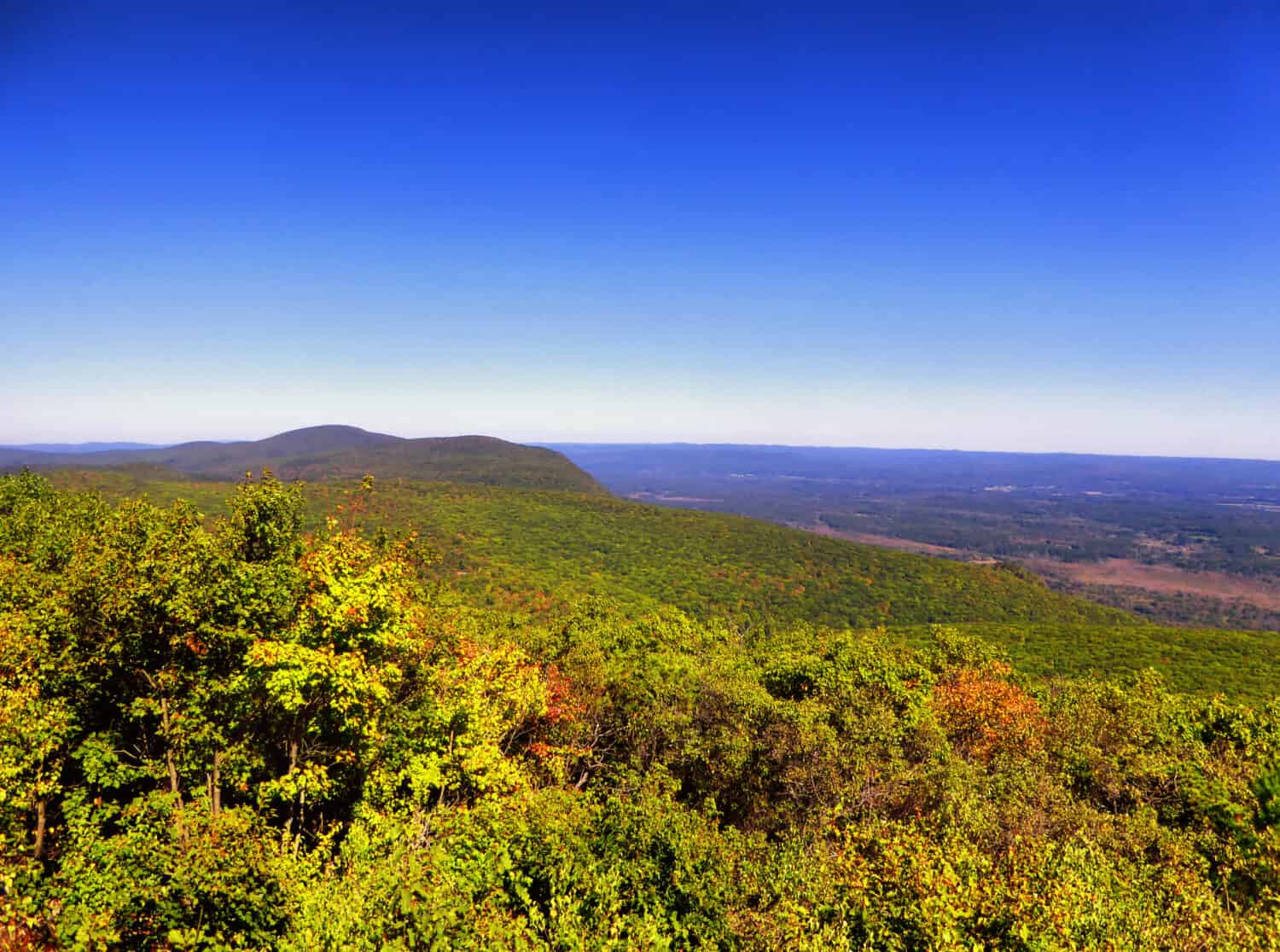
Connecticut’s tallest mountain is Bear Mountain with a peak of 2,316 feet.
©Shanshan0312/Shutterstock.com
Animals Found On and Near Connecticut’s Tallest Mountain
While hiking the trail to the top, you may encounter some lovely wildlife. Follow along to discover 8 animals that live atop or near Bear Mountain, Connecticut.
1. Spotted Salamander
One animal you may encounter while hiking up Bear Mountain in Connecticut is the spotted salamander. Its scientific name is Ambystoma maculatum. This smooth salamander is found throughout the eastern United States. Spotted salamanders live in forests near bodies of water like ponds, lakes, or creeks. To breed, they need water. Spotted salamanders range in color and size. They are usually black or dark green/blue with yellow-orange spots. Spotted salamanders are about 5.9 to 9.8 inches long. They have large snouts and thick bodies. This salamander species mainly eats insects, spiders, snails, and slugs. Spotted salamanders are quick and flexible. They hide from predators but also have many natural predators including snakes, turtles, and raccoons.
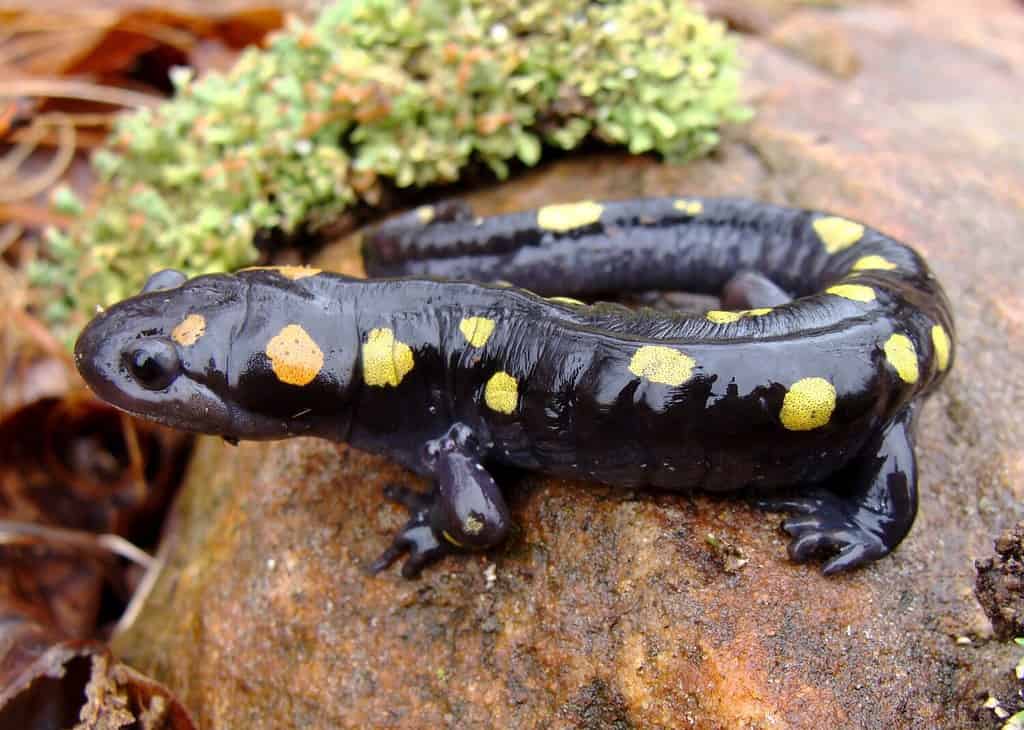
Spotted salamanders measure about 5.9 to 9.8 inches long.
©Matt Jeppson/Shutterstock.com
2. Northern Dusky Salamander
Another salamander you can find on this mountain is the northern dusky salamander, which looks vastly different from the spotted salamander. The northern dusky salamander is listed as Least Concern on the IUCN Red List. They are smooth and wet amphibians native to parts of the northeast United States, including Connecticut.
Northern dusky salamanders live in forests and high elevations. They prefer living in moist and saturated soil, usually near a spring or pond. Forest cover is just as important as a water source. Northern dusky salamanders have many predators. They are preyed on by eastern garter snakes and birds. Sometimes, larger salamanders eat this species.
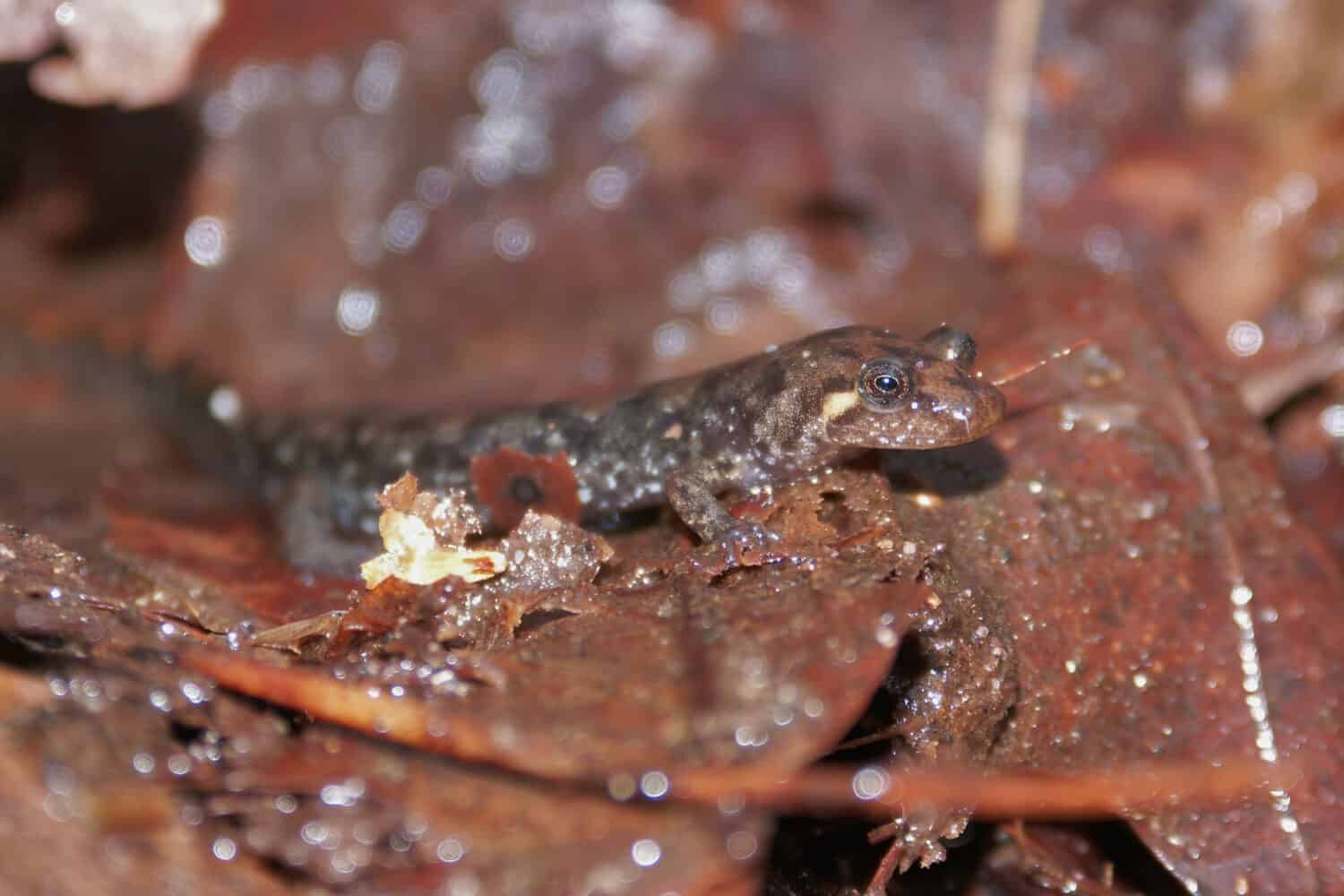
Northern dusky salamanders are listed as Least Concern on the IUCN Red List.
©HWall/Shutterstock.com
3. White-breasted Nuthatch
Moving away from slimy and smooth amphibians, is the white-breasted nuthatch, a beautiful and small to medium bird. They are members of the Sittidae family. White-breasted nuthatch birds are about 6.1 inches long, sometimes shorter, and sometimes taller. These birds are easy to recognize because of their short tails and long stocky heads.
White-breasted nuthatch birds have black or grey caps on their heads. They also have white breasts and bellies and blue or grey wings with white tips. There is little difference between female and male white-breasted nuthatch birds. While these birds mainly live in the lowlands like parks, neighborhoods, and orchards, they’ve been recorded breeding at elevations of up to 5,495 feet.

White-breasted nuthatch birds are medium-sized birds about 6.1 inches long.
©Jim Nelson/Shutterstock.com
4. Common Grackle
The common grackle is another bird species you can find while hiking Bear Mountain in Connecticut. The common grackle is sadly listed as Near Threatened on the IUCN Red List. Common grackles have dark blue, black, and shiny feathers. Their heads are iridescent. This shininess is more noticeable in male common grackles.
Common grackles measure about 11 to 13 inches long. They often weigh less than 5 ounces. This sparkling bird species lives in most of the eastern and central United States. Some common grackles migrate from the cold north to the south in winter, while others are permanent residents in the southern United States. These lovely birds are intelligent foragers. Experts have observed them cunningly stealing food from other birds.
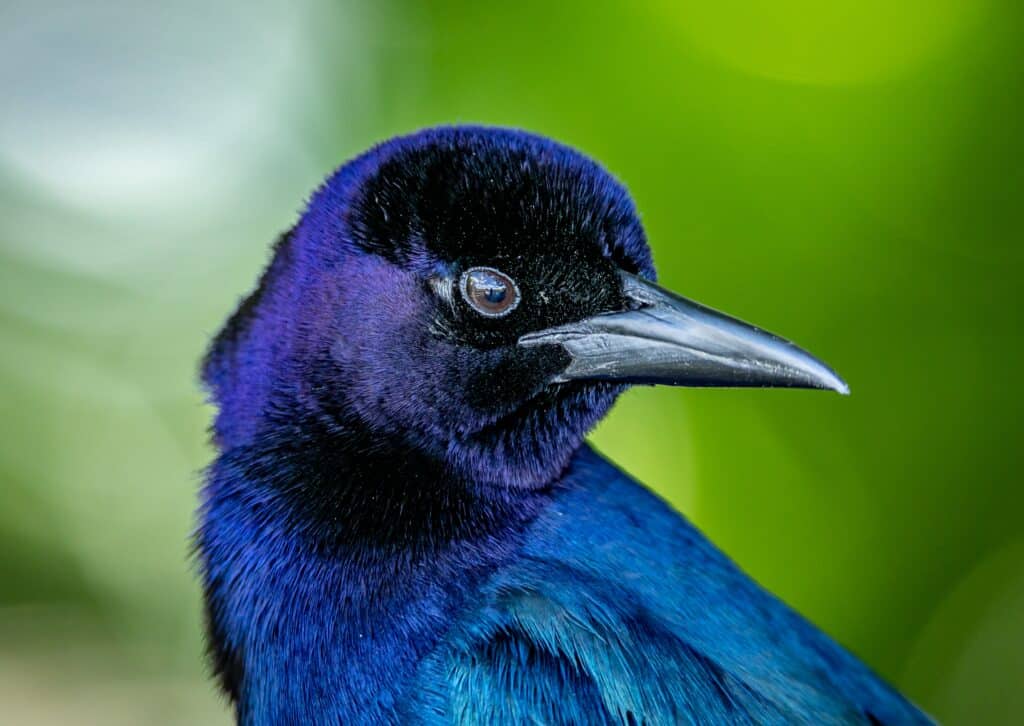
The common grackle forages on the ground, in shallow water, or shrubs and trees.
©Holly S. Cannon/Shutterstock.com
5. Tufted Titmouse
Another bird on our list is the tufted titmouse. This adorable and small songbird has a gentle appearance with white, grey, black, yellow, and orange feathers. The tufted titmouse is only about 5.5 to 6.3 inches long. They also weigh much less than an ounce.
Tufted titmouse birds live for about two years. They thrive in parts of the eastern United States, including Connecticut. Interestingly, tufted titmouse birds aren’t migratory. However, they travel when looking for food and have spread far from their native range of the Ohio and Mississippi River basins. Their range has extended northward, which may be the result of bird feeders. This tiny bird isn’t picky. While they are mainly foragers for nuts and berries, they also consume insects including caterpillars, an important food during summer.
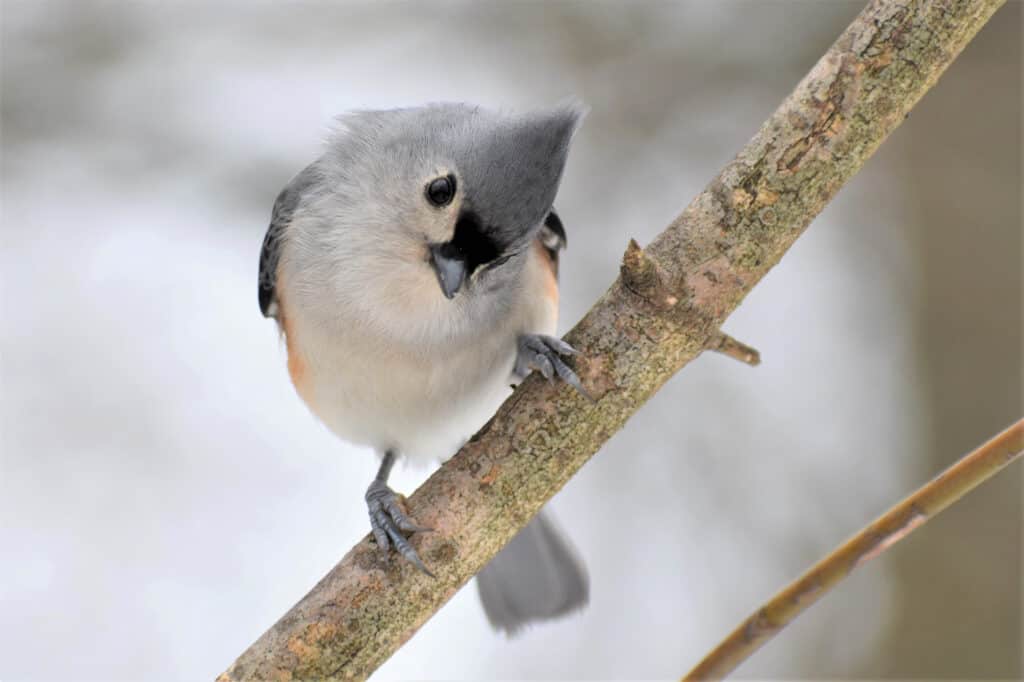
The tufted titmouse is a small songbird that frequents bird feeders.
©Lester Graham/Shutterstock.com
6. North American Black Bear
Pivoting away from small animals, the next animal on our list is the North American black bear. Although they are found atop Bear Mountain in Connecticut, they aren’t a common sight. If you encounter a black bear on your travels, simply quietly move away. Don’t run, play dead, or take your eyes off of the bear. If the bear is moving towards you out of curiosity, make as much noise as possible. Stretch tall and wave your arms to look big.
North American black bears are strong. These large and fluffy mammals have a bite force of up to 800 PSI. North American black bears are most common in the northwestern part of Connecticut. Experts estimate there are about 1,000 to 1,200 black bears in the state.
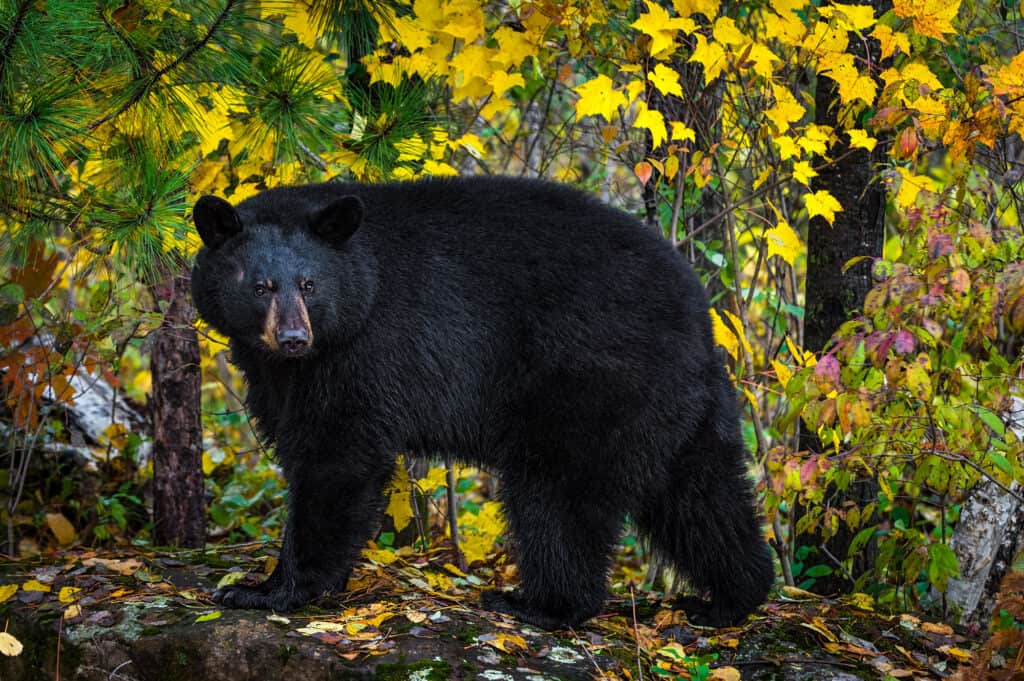
Black bears are omnivorous, meaning they can feed on a wide range of plant and animal matter.
©Holly Kuchera/Shutterstock.com
7. Red Fox
Another mammal you may find on your hike to the top of Bear Mountain is the red fox. Red foxes are extremely common in the state. You’re more likely to see a red fox in the wild, than a black bear. Although red foxes are slender and smaller than black bears, never provoke one in the wild. They can attack and transmit diseases.
Red foxes are extremely smart animals. While they live in urban areas near humans, they are rarely seen. Researchers believe that red foxes can memorize the day and time trash is placed outside.
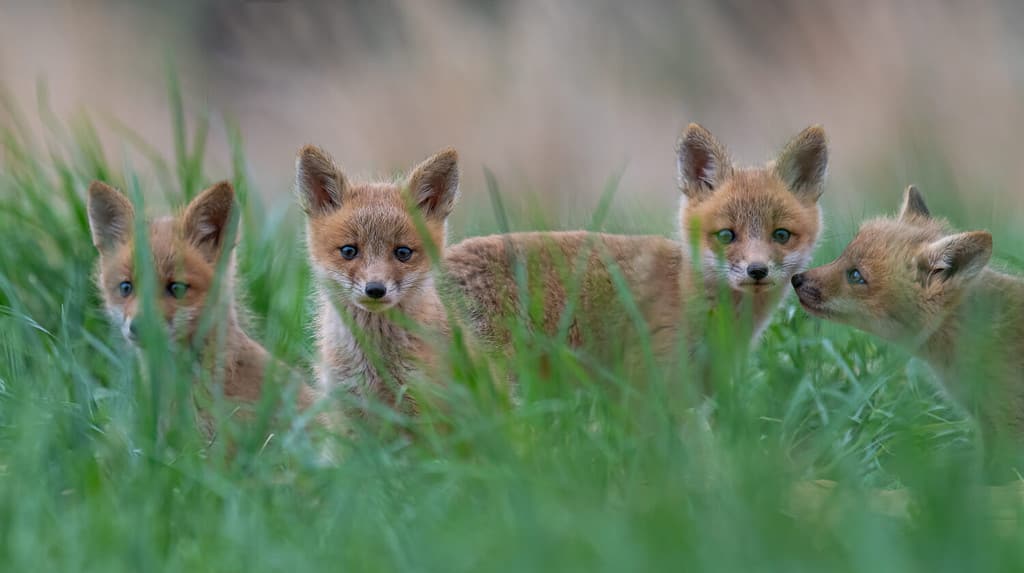
Young foxes soon start to explore their vocalization abilities.
©Randy G. Lubischer/Shutterstock.com
8. White-footed Mouse
White-footed mice are other animals you may see while on Bear Mountain, Connecticut’s tallest mountain. The white-footed mouse is a small mouse that only weighs about 0.79 ounces. This tiny mouse is native to North America. Its range stretches from Canada to Mexico.
White-footed mice can live up to 96 months. However, they usually only survive about half of that (45 to 46 months). White-footed mice are omnivores. They eat insects, seeds, and sometimes berries. Although most white-footed mice live outdoors, some build nests in between walls in buildings. White-footed mice that live outdoors use abandoned bird nests as their homes.
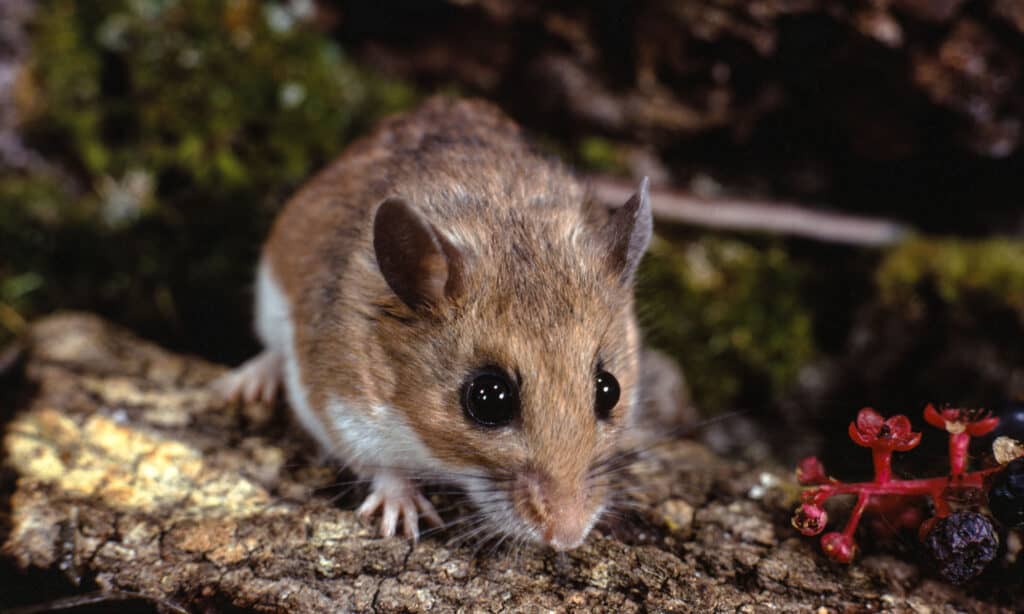
White-footed mice can live up to 96 months.
©iStock.com/Weber
Summary of 8 Animals That Lurk Atop Connecticut’s Tallest Mountain
| Animal | Fun Fact | |
|---|---|---|
| 1 | Spotted Salamander | They need water to breed |
| 2 | Northern Dusky Salamander | These salamanders prefer to live in moist, saturated soil |
| 3 | White-breasted Nuthatch | They’ve been recorded breeding at elevations of up to 5,495 feet |
| 4 | Common Grackle | Known for their stunning dark blue, black, shiny feathers, and iridescent heads |
| 5 | Tufted Titmouse | Their range is shifting north because more people are keeping bird feeders |
| 6 | North American Black Bear | They have a bite force of up to 800 PSI |
| 7 | Red Fox | When living near urban areas – they can memorize the time of day that trash is put out |
| 8 | White-footed Mouse | They use abandoned bird nests as their homes |
The photo featured at the top of this post is © iStock.com/Daniel Hanscom
Thank you for reading! Have some feedback for us? Contact the AZ Animals editorial team.






